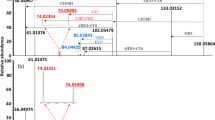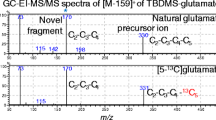Abstract
Direct reductive methylation of peptides is a common method for quantitative proteomics. It is an active derivatization technique; with participation of the dimethylamino group, the derivatized peptides preferentially release intense a1 ions. The advantageous generation of a1 ions for quantitative proteomic profiling, however, is not desirable for targeted proteomic quantitation using multiple reaction monitoring mass spectrometry; this mass spectrometric method prefers the derivatizing group to stay with the intact peptide ions and multiple fragments as passive mass tags. This work investigated collisional fragmentation of peptides whose amine groups were derivatized with five linear ω-dimethylamino acids, from 2-(dimethylamino)-acetic acid to 6-(dimethylamino)-hexanoic acid. Tandem mass spectra of the derivatized tryptic peptides revealed different preferential breakdown pathways. Together with energy resolved mass spectrometry, it was found that shutting down the active participation of the terminal dimethylamino group in fragmentation of derivatized peptides is possible. However, it took a separation of five methylene groups between the terminal dimethylamino group and the amide formed upon peptide derivatization. For the first time, the gas-phase fragmentation of peptides derivatized with linear ω-dimethylamino acids of systematically increasing alkyl chain lengths is reported.

ᅟ














Similar content being viewed by others
References
Yao, X.: Derivatization or not: a choice in quantitative proteomics. Anal. Chem. 83, 4427–4439 (2011)
Ross, P.L., Huang, Y.N., Marchese, J.N., Williamson, B., Parker, K., Hattan, S., Khainovski, N., Pillai, S., Dey, S., Daniels, S., Purkayastha, S., Juhasz, P., Martin, S., Bartlet-Jones, M., He, F., Jacobson, A., Pappin, D.J.: Multiplexed protein quantitation in saccharomyces cerevisiae using amine-reactive isobaric tagging reagents. Mol. Cell. Proteomics 3, 1154–1169 (2004)
Shi, Y., Bajrami, B., Yao, X.: Passive and active fragment ion mass defect labeling: distinct proteomics potential of iodine-based reagents. Anal. Chem. 81, 6438–6448 (2009)
Ow, S.Y., Salim, M., Noirel, J., Evans, C., Rehman, I., Wright, P.C.: iTRAQ underestimation in simple and complex mixtures: “the good, the bad, and the ugly”. J. Proteome Res. 8, 5347–5355 (2009)
Karp, N.A., Huber, W., Sadowski, P.G., Charles, P.D., Hester, S.V., Lilley, K.S.: Addressing accuracy and precision issues in iTRAQ quantitation. Mol. Cell. Proteomics 9, 1885–1897 (2010)
Hsu, J.L., Huang, S.Y., Chow, N.H., Chen, S.H.: Stable-isotope dimethyl labeling for quantitative proteomics. Anal. Chem. 75, 6843–6852 (2003)
Boersema, P.J., Raijmakers, R., Lemeer, S., Mohammed, S., Heck, A.J.: Multiplex peptide stable isotope dimethyl labeling for quantitative proteomics. Nat. Protoc. 4, 484–494 (2009)
Wu, Y., Wang, F., Liu, Z., Qin, H., Song, C., Huang, J., Bian, Y., Wei, X., Dong, J., Zou, H.: Five-plex isotope dimethyl labeling for quantitative proteomics. Chem. Commun. (Camb.) 50, 1708–1710 (2014)
Koehler, C.J., Arntzen, M.O., de Souza, G.A., Thiede, B.: An approach for triplex-isobaric peptide termini labeling (Triplex-IPTL). Anal. Chem. 85, 2478–2485 (2013)
Bamberger, C., Pankow, S., Park, S.K., Yates, J.R.: Interference-free proteome quantification with MS/MS-based isobaric isotopologue detection. J. Proteome Res. 13, 1494–1501 (2014)
Zhou, Y., Shan, Y., Wu, Q., Zhang, S., Zhang, L., Zhang, Y.: Mass defect-based pseudo-isobaric dimethyl labeling for proteome quantification. Anal. Chem. 85, 10658–10663 (2013)
Kovanich, D., Cappadona, S., Raijmakers, R., Mohammed, S., Scholten, A., Heck, A.J.: Applications of stable isotope dimethyl labeling in quantitative proteomics. Anal. Bioanal. Chem. 404, 991–1009 (2012)
Hsu, J.L., Huang, S.Y., Shiea, J.T., Huang, W.Y., Chen, S.H.: Beyond quantitative proteomics: signal enhancement of the A1 ion as a mass tag for peptide sequencing using dimethyl labeling. J. Proteome Res. 4, 101–108 (2005)
Fu, Q., Li, L.: De novo sequencing of neuropeptides using reductive isotopic methylation and investigation of ESI QTOF MS/MS fragmentation pattern of neuropeptides with N-terminal dimethylation. Anal. Chem. 77, 7783–7795 (2005)
Locke, S.J., Leslie, A.D., Melanson, J.E., Pinto, D.M.: Deviation from the mobile proton model in amino-modified peptides: implications for multiple reaction monitoring analysis of peptides. Rapid Commun. Mass Spectrom. 20, 1525–1530 (2006)
Rose, C.M., Merrill, A.E., Bailey, D.J., Hebert, A.S., Westphall, M.S., Coon, J.J.: Neutron encoded labeling for peptide identification. Anal. Chem. 85, 5129–5137 (2013)
McAlister, G.C., Huttlin, E.L., Haas, W., Ting, L., Jedrychowski, M.P., Rogers, J.C., Kuhn, K., Pike, I., Grothe, R.A., Blethrow, J.D., Gygi, S.P.: Increasing the multiplexing capacity of TMTs using reporter ion isotopologues with isobaric masses. Anal. Chem. 84, 7469–7478 (2012)
Werner, T., Becher, I., Sweetman, G., Doce, C., Savitski, M.M., Bantscheff, M.: High-resolution enabled TMT 8-plexing. Anal. Chem. 84, 7188–7194 (2012)
Hebert, A.S., Merrill, A.E., Stefely, J.A., Bailey, D.J., Wenger, C.D., Westphall, M.S., Pagliarini, D.J., Coon, J.: Amine-reactive neutron-encoded labels for highly plexed proteomic quantitation. Mol. Cell. Proteomics 12, 3360–3369 (2013)
Abbatiello, S.E., Mani, D.R., Schilling, B., Maclean, B., Zimmerman, L.J., Feng, X., Cusack, M.P., Sedransk, N., Hall, S.C., Addona, T., Allen, S., Dodder, N.G., Ghosh, M., Held, J.M., Hedrick, V., Inerowicz, H.D., Jackson, A., Keshishian, H., Kim, J.W., Lyssand, J.S., Riley, C.P., Rudnick, P., Sadowski, P., Shaddox, K., Smith, D., Tomazela, D., Wahlander, A., Waldemarson, S., Whitwell, C.A., You, J., Zhang, S., Kinsinger, C.R., Mesri, M., Rodriguez, H., Borchers, C.H., Buck, C., Fisher, S.J., Gibson, B.W., Liebler, D., Maccoss, M., Neubert, T.A., Paulovich, A., Regnier, F., Skates, S.J., Tempst, P., Wang, M., Carr, S.A.: Design, implementation, and multisite evaluation of a system suitability protocol for the quantitative assessment of instrument performance in liquid chromatography-multiple reaction monitoring-MS (LC-MRM-MS). Mol. Cell. Proteomics 12, 2623–2639 (2013)
DeSouza, L.V., Taylor, A.M., Li, W., Minkoff, M.S., Romaschin, A.D., Colgan, T.J., Siu, K.W.: Multiple reaction monitoring of mTRAQ-labeled peptides enables absolute quantification of endogenous levels of a potential cancer marker in cancerous and normal endometrial tissues. J. Proteome Res. 7, 3525–3534 (2008)
DeSouza, L.V., Krakovska, O., Darfler, M.M., Krizman, D.B., Romaschin, A.D., Colgan, T.J., Siu, K.W.: mTRAQ-based quantification of potential endometrial carcinoma biomarkers from archived formalin-fixed paraffin-embedded tissues. Proteomics 10, 3108–3116 (2010)
Oppermann, F.S., Klammer, M., Bobe, C., Cox, J., Schaab, C., Tebbe, A., Daub, H.: Comparison of SILAC and mTRAQ quantification for phosphoproteomics on a quadrupole orbitrap mass spectrometer. J. Proteome Res. 12, 4089–4100 (2013)
Gropengiesser, J., Varadarajan, B.T., Stephanowitz, H., Krause, E.: The relative influence of phosphorylation and methylation on responsiveness of peptides to MALDI and ESI mass spectrometry. J. Mass Spectrom. 44, 821–831 (2009)
Maclean, B., Tomazela, D.M., Abbatiello, S.E., Zhang, S., Whiteaker, J.R., Paulovich, A.G., Carr, S.A., Maccoss, M.J.: Effect of collision energy optimization on the measurement of peptides by selected reaction monitoring (SRM) mass spectrometry. Anal. Chem. 82, 10116–10124 (2010)
Eschweiler, W.: Replacement of hydrogen atoms by the methyl group by formaldehyde, bound at nitrogen. BER 38, 880–882 (1905)
Clarke, H.T., Gillespie, H.B., Weisshaus, S.Z.: Action of formaldehyde on amines and amino acids. J. Am. Chem. Soc. 55, 4571–4587 (1933)
Harrison, A.G.: To B or not to B: the ongoing saga of peptide B ions. Mass Spectrom. Rev. 28, 640–654 (2009)
Harrison, A.G., Csizmadia, I.G., Tang, T.H., Tu, Y.P.: Reaction competition in the fragmentation of protonated dipeptides. J. Mass Spectrom. 35, 683–688 (2000)
McLafferty, F.W.: Mass spectrometric analysis: molecular rearrangements. Anal. Chem. 31, 82–87 (1959)
Csonka, I.P., Paizs, B., Lendvay, G., Suhai, S.: Proton mobility and main fragmentation pathways of protonated lysylglycine. Rapid Commun. Mass Spectrom. 15, 1457–1472 (2001)
He, Y., Reilly, J.P.: Does a charge tag really provide a fixed charge? Angew. Chem. Int. Ed. Engl. 47, 2463–2465 (2008)
Yalcin, T., Harrison, A.G.: Ion chemistry of protonated lysine derivatives. J. Mass Spectrom. 31, 1237–1243 (1996)
Farrugia, J.M., Taverner, T., O’Hair, R.A.J.: Side-chain involvement in the fragmentation reactions of the protonated methyl esters of histidine and its peptides. Int. J. Mass Spectrom. 209, 99–112 (2001)
Tsaprailis, G., Nair, H., Zhong, W., Kuppannan, K., Futrell, J.H., Wysocki, V.H.: A mechanistic investigation of the enhanced cleavage at histidine in the gas-phase dissociation of protonated peptides. Anal. Chem. 76, 2083–2094 (2004)
Hiserodt, R.D., Brown, S.M., Swijter, D.F., Hawkins, N., Mussinan, C.J.: A study of b1 + H2O and b1-ions in the product ion spectra of dipeptides containing n-terminal basic amino acid residues. J. Am. Soc. Mass Spectrom. 18, 1414–1422 (2007)
van der Rest, G., He, F., Emmett, M.R., Marshall, A.G., Gaskell, S.J.: Gas-phase cleavage of PTC-derivatized electrosprayed tryptic peptides in an FT-ICR trapped-ion cell: mass-based protein identification without liquid chromatographic separation. J. Am. Soc. Mass Spectrom. 12, 288–295 (2001)
Diego, P.A., Bajrami, B., Jiang, H., Shi, Y., Gascon, J.A., Yao, X.: Site-preferential dissociation of peptides with active chemical modification for improving fragment ion detection. Anal. Chem. 82, 23–27 (2010)
Laskin, J., Yang, Z., Song, T., Lam, C., Chu, I.K.: Effect of the basic residue on the energetics, dynamics, and mechanisms of gas-phase fragmentation of protonated peptides. J. Am. Chem. Soc. 132, 16006–16016 (2010)
Barlow, C.K., O’Hair, R.A.J.: Gas-phase peptide fragmentation: how understanding the fundamentals provides a springboard to developing new chemistry and novel proteomic tools. J. Mass Spectrom. 43, 1301–1319 (2008)
Acknowledgments
The authors greatly appreciate financial support from the Cystic Fibrosis Foundation (YAO07XX0) and the NCI/NIH (1R21CA155536-01). They thank Song Li for his assistance with NMR spectroscopy and the Leadbeater Lab for use of their scientific microwave.
Author information
Authors and Affiliations
Corresponding author
Electronic supplementary material
Below is the link to the electronic supplementary material.
ESM 1
(DOCX 4356 kb)
Rights and permissions
About this article
Cite this article
McShane, A.J., Shen, Y., Castillo, M.J. et al. Peptide Dimethylation: Fragmentation Control via Distancing the Dimethylamino Group. J. Am. Soc. Mass Spectrom. 25, 1694–1704 (2014). https://doi.org/10.1007/s13361-014-0951-7
Received:
Revised:
Accepted:
Published:
Issue Date:
DOI: https://doi.org/10.1007/s13361-014-0951-7




